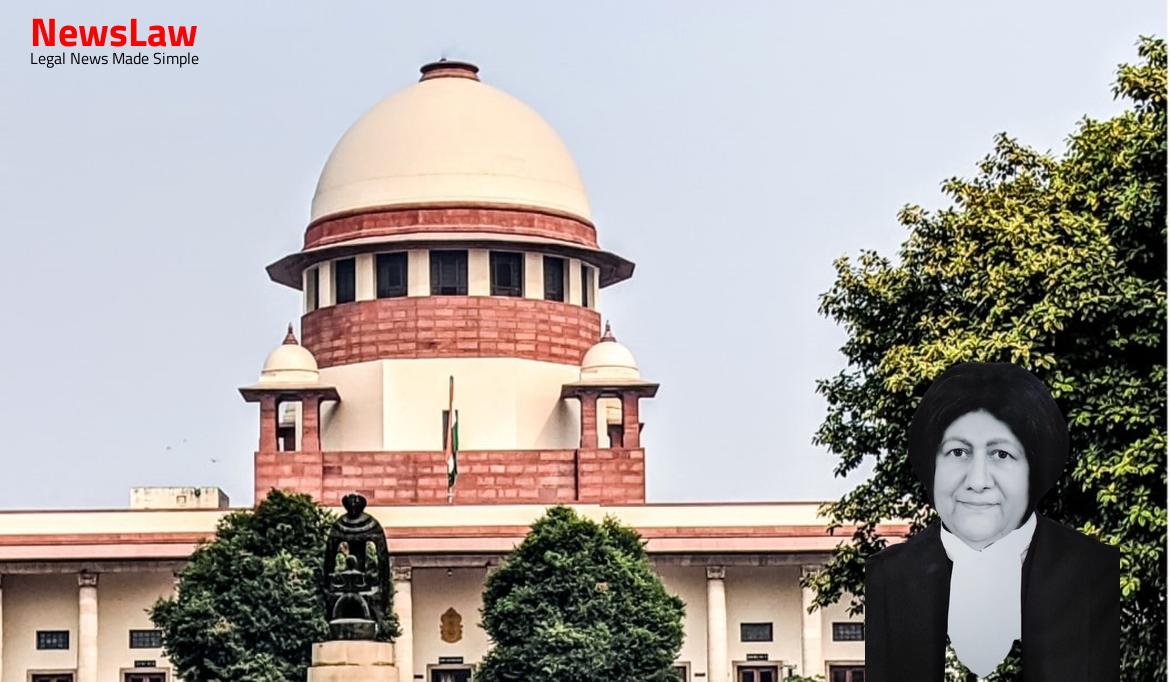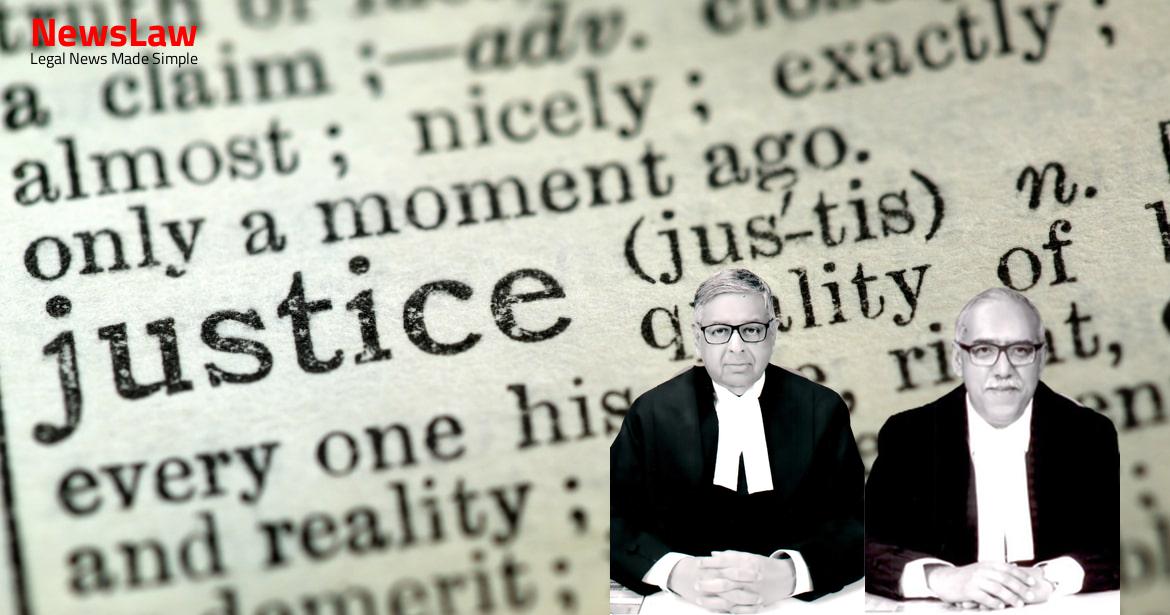Explore the intricate legal analysis by the court on the application of promissory estoppel in the context of changes in government policies. The case delves into the balance between upholding commitments made by the government and the necessity of adapting policies in the public interest. The analysis sheds light on how courts navigate the complexities of equitable doctrines in the realm of fiscal matters, considering both individual rights and broader societal concerns.
Facts
- The impugned policy of withdrawal of benefit/incentive to the original writ petitioners was held to be retrospective and not retroactive.
- Notification 16/2008 dated 27.03.2008 was quashed and set aside based on the bar of promissory estoppel.
- One learned Judge allowed the writ petitions while another held they should be dismissed.
- The incentive was reduced from refund of entire duty paid to 34% of the total duty paid for the respondents.
- The High Court set aside subsequent notifications/industrial policies similar to Notification No. 16 of 2008 applicable to the Kutch area of Gujarat.
- The Government of India announced an Incentive Scheme for setting up new industries in the earthquake-affected District of Kutch after a devastating earthquake in 2001.
- The scheme granted exemption from duty of excise to goods cleared from new industrial units in Kutch District for a specified period.
- The original writ petitioners invested a substantial amount in setting up new units in Kutch District based on the promised incentive of duty refund.
- Subsequent notifications, particularly No 16/2008-CE, amended the incentive scheme by reducing the entitlement of refund to only 34% of the duty paid.
- The reduction in the refund entitlement was challenged before the High Court by the original writ petitioners.
- The High Court set aside the subsequent notifications on the ground of violating the doctrine of promissory estoppel.
- The notifications were deemed to change the basis of the promised incentive, leading to the reduction in entitlement for the refund of excise duty.
- The original writ petitioners contended that the subsequent notification breached the principle of promissory estoppel as the promised incentive was curtailed before the agreed-upon period of five years expired.
Also Read: Court’s Analysis on Interim Order for Appointing Contractual Employees
Arguments
- The exemption notification issued under Section 5A will not affect the suspension of duty collection under normal circumstances.
- The subsequent notification cannot be considered to be hit by the principle of promissory estoppel as it was implicit that the exemption could be rescinded or modified if public interest demands.
- The amendment notification treats all industries at par and is non-discriminatory.
- Exemptions are subject to periodic review to curb misuse and for revenue considerations.
- The High Court erred in not appreciating the reasons for the subsequent notification.
- The amendment notification was issued in public interest and interest of revenue.
- The doctrine of promissory estoppel cannot be invoked against exercises of powers under the statute.
- The doctrine of promissory estoppel is not applicable in fiscal matters.
- The impugned notification clarified the refund mechanism regarding duty paid in cash/PLA.
- The incentive promised under the original notification was not dependent on the extent of value addition.
- The High Court erred in quashing the notification without considering public interest and revenue concerns.
- The Court has to presume validity of the notification and not examine it with a microscopic view.
- The High Court misinterpreted the notification as a withdrawal of exemption benefit when it was clarificatory in nature.
- The respondents suffered a loss due to the amendment to the notification.
- The amendment notification was issued in public interest and government’s power to withdraw exemptions was permissible.
- The government’s change in stand was made on account of public policy regarding misuse of exemptions by unscrupulous manufacturers.
- Learned Senior Advocates/Counsel representing the respondents-original writ petitioners supported the High Court’s judgment
- They argued that the High Court was correct in setting aside the notification as it was retrospective and not retro-active
- They also contended that the notification violated the doctrine of promissory estoppel
- The notification allowed for the recovery of refunds with interest in case of wrongful claims/grants
Also Read: Court’s Legal Analysis in Tax Law Challenge
Analysis
- The High Court held that the incentive as per the original notification was required to be implemented, leading to a direction for the refund of the differential amount to the writ petitioners.
- The writ petitions were allowed mainly on the grounds of the doctrine of promissory estoppel.
- The subsequent notifications were deemed clarificatory, aimed at refunding excise duty paid genuinely on actual manufacturing of goods, rather than on paper-only manufacturing.
- The subsequent notifications do not take away any vested rights under earlier policies and are not hit by the doctrine of promissory estoppel, being issued in public and revenue interest to achieve the original purpose of incentivizing investments in new undertakings.
- As the subsequent notifications are clarificatory and serve public interest, they are to be applied retrospectively and are not considered irrational or arbitrary.
- Government is bound to implement its promise if a person has acted on an unequivocal promise by the Government
- Withdrawal of incentive only justified if it is on grounds of supervening public interest
- The subsequent notifications clarified the refund of excise duty shall be based on actual value addition to prevent tax evasion.
- The subsequent notifications did not take away any vested rights granted under earlier notifications.
- There were reports of misuse prompting the government to issue clarificatory notifications.
- The intention was to provide excise duty exemptions only for genuine manufacturing activities.
- The subsequent notifications were issued in the public interest after thorough analysis of tax evasion cases.
- Promissory estoppel cannot be invoked without clear, sound, and positive evidence.
- The notifications were designed to achieve the object of providing incentive/exemption.
- The High Courts erred in finding the subsequent notifications in violation of promissory estoppel.
- Doctrine of promissory estoppel cannot be invoked for enforcement of a promise made contrary to law.
- Government or public authority cannot be compelled to act against the statute.
- Principles of promissory estoppel cannot be invoked when public interest warrants.
- Withdrawal of exemption ‘in public interest’ is a matter of policy.
- Government has the discretion to modify or withdraw exemption notifications in public interest.
- The courts do not interfere with fiscal policy decisions made in public interest.
- Promissory estoppel doctrine must yield when equity demands, considering public interest.
- Applicability of promissory estoppel against the Government depends on balance of equity or public interest.
- Explanatory Acts are passed to clear up doubts or omissions in previous Acts.
- Legislation in economic matters is empirical and based on trial and error.
- Government’s promise enforceable if relied upon and acted upon by the promisee.
- Promissory estoppel is an equitable doctrine that must be molded to suit specific situations.
- Doctrine of promissory estoppel applicable against the Government to prevent fraud or injustice.
- Doctrine cannot compel the Government to act contrary to law or beyond its authority.
- Presumption against retrospective operation not applicable to declaratory statutes.
- Declaratory Acts are usually held to be retrospective for clarity and consistency.
- Taxing statutes should be interpreted strictly at the threshold stage.
- Legislature cannot anticipate all distortions or abuses of its legislation.
- Judging the constitutionality of legislation by its provisions rather than its potential abuses or inequities.
Also Read: Clarification on Default Bail Conditions
Decision
- The High Court dismissed the petitions challenging subsequent notifications/industrial policies.
- The challenge to the subsequent notifications/industrial policies failed.
- Clarification that the judgment will not affect excise duty already refunded.
- Pending refund applications to be decided based on subsequent notifications/industrial policies challenged in the High Courts.
- Civil Appeals regarding certain notification numbers were dismissed as the Excise authorities had already allowed the refund in line with those notifications.
- The High Court declined to entertain petitions for refund of excise duty under Article 226 of the Constitution.
- The High Court did not address the challenge to specific notification numbers due to a previous decision under consideration by the Court.
- Consequently, all appeals were allowed in relation to the High Court’s decision on quashing subsequent notifications and industrial policies.
- The High Court’s decision to quash the notifications based on promissory estoppel was upheld.
- Similar decisions made by other High Courts were also upheld in these appeals.
Case Title: UNION OF INDIA & ANR.ETC. Vs. M/S V.V.F.LTD.ETC.ETC. (2020 INSC 347)
Case Number: C.A. No.-002256-002263 / 2020



